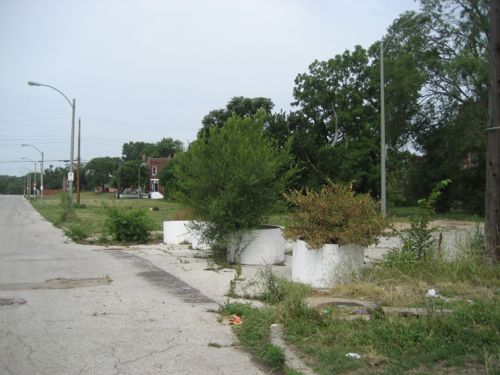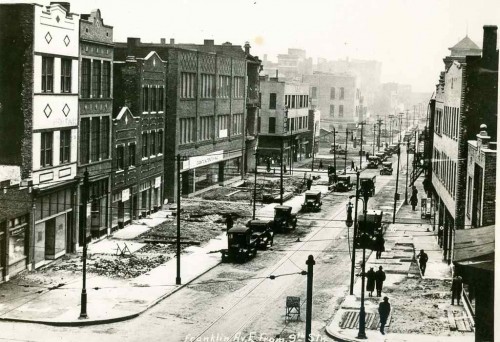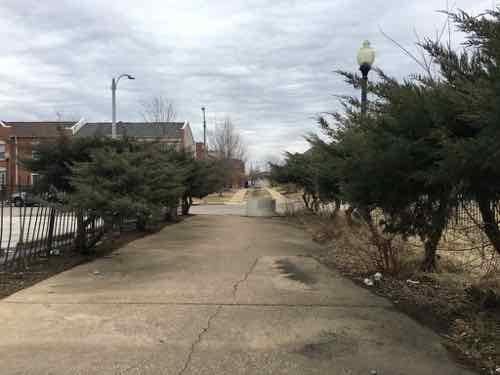Opinion: Closed Streets Do Not Reduce Crime
The recent non-scientific Sunday Poll was about closed streets and crime, prompted by a news story about new research at Saint Louis University:
St. Louis’ often-interrupted street grid is the outgrowth of the 1970s-era “defensible space” strategy to address rising crime championed by Oscar Newman, a prominent urban planner who was a Washington University architecture professor in the mid-1960s, according to the paper. That idea stems from the notion that an area is safer when residents feel a sense of ownership and control, which Newman described as allowing neighbors to focus their attention on “removing criminal activity from their communities.”
St. Louis became the birthplace of such ideas, according to the paper. And they haven’t had the desired effect. (Post-Dispatch)
Below is one such example where “Schoemehl pots”, just sections of sewer pipe, were used to limit vehicular traffic.

Their paper’s conclusion:
Oscar Newman’s defensible space theory is a product of St. Louis’s mid-century history. It is perhaps unsurprising, therefore, that St. Louis also offers a large-scale implementation of defensible space in the street barriers that constrict swaths of the city’s geography. The barriers scattered across the city’s landscape are a testament not only to former Mayor Vincent Schoemehl, the elected official most closely associated with the barriers, but to Newman himself. We have developed the most comprehensive known list of closures in the city, and find that the density of closures is not associated with less crime in neighborhoods. Our finding is an important one for St. Louis, given that addressing crime is the argument being made explicitly in the legislation that authorizes more recent installations of barriers. For other municipalities that may be considering defensible space or other techniques to “design out” crime, our findings suggest that street closures are at best ineffective and at worst associated with higher rates of violent crime in neighborhoods. They may also have secondary effects on first responders’ ability to reach the neighborhoods they serve. (Research paper)
I completely agree with the conclusions of the researchers, but I also think they should be looking at earlier changes to the urban street grid. As I’ve said before, when Harold Bartholomew (1889-1989) first arrived in St. Louis in the nineteen teens he quickly began assaulting our fine network of public streets. Writing decades later in the 1947 plan:
Since 1916 St. Louis has expended over $40,000,000 in opening, widening, connecting, and extending the system of major streets. Much has been accomplished in converting a horse and buggy street system to automobile needs. As the total volume of traffic increases, however, certain new needs arise. An example is the desirability of grade separations at extremely heavy intersections, such as at Grand and Market and at Kingshighway and Lindell. Likewise there is a need for complete separation of grade where traffic volume is sufficiently heavy to justify the cost involved. The Federal Government, which has helped finance our splendid system of national highways, has recently revised its policies and Congress has appropriated substantial funds to aid the cities in the construction of express highways and for facilitation of traffic flows from certain selected state highways through metropolitan areas to the central business districts of large cities. (1947 Plan)
In just three decades St. Louis spent today’s equivalent of nearly a half a billion dollars on dramatic changes to the street grid. Half a billion!

The reference to the “horse and buggy street system” illustrates he didn’t think it was suitable for the automobile. Bartholomew, a civil engineer by training, was no doubt influenced by the City Beautiful movement.
City Beautiful movement, American urban-planning movement led by architects, landscape architects, and reformers that flourished between the 1890s and the 1920s. The idea of organized comprehensive urban planning arose in the United States from the City Beautiful movement, which claimed that design could not be separated from social issues and should encourage civic pride and engagement. (Britannica)
This was soon followed by the modernists and their vision for roads to connect everything. The Futurama exhibit at the 1939 World’s Fair was hugely popular, helped shape legislation that let to destructive urban renewal projects, interstate highways slicing through cities, etc. See original 23-minute 1939 Futurama promo video.
Oscar Newman was born in 1935, so he was barely around during the 1939 fair. With the Great Depression & WWII the ideas from Futurama were on hold until he was a teen. Newman likely went along with most others, not foreseeing any problems with additional alterations to the street grid.
By the time republished his 1972 book urban renewal & highway projects had further disrupted the street grid beyond recognition. These changes are cumulative, not isolated. Our street grid was designed for the horse and buggy times — but that’s what made it go great. Street grids can take little changes and still function. St. Louis had decades of massive overwhelming changes to the street grid.
It has proven to be excessive. Abandonment, crime, etc are the results. I don’t know that it’s repairable.

The results from Sunday’s non-scientific poll:
Q: Agree or disagree: City streets closed to through traffic reduce crime.
- Strongly agree: 1 [3.13%]
- Agree: 2 [6.25%]
- Somewhat agree: 6 [18.75%]
- Neither agree or disagree: 2 [6.25%]
- Somewhat disagree: 2 [6.25%]
- Disagree: 9 [28.13%]
- Strongly disagree: 9 [28.13%]
- Unsure/No Answer: 1 [3.13%]
More than half correct don’t think closed streets reduce crime.
— Steve Patterson